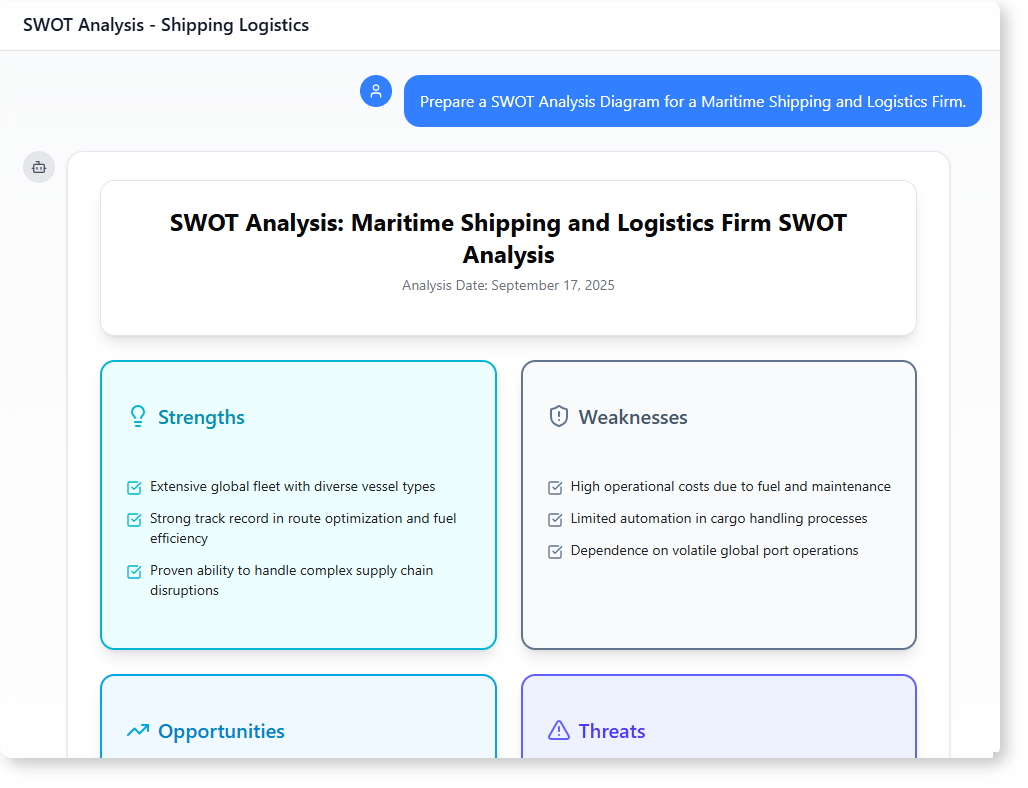Now Reading: How to Generate a Professional SWOT Analysis with AI-Powered Modeling Software
-
01
How to Generate a Professional SWOT Analysis with AI-Powered Modeling Software
How to Generate a Professional SWOT Analysis with AI-Powered Modeling Software
Why a SWOT Analysis Matters in the Shipping Industry
A shipping company doesn’t just sail routes — it navigates risks, adapts to regulations, and keeps its supply chain running. That’s why understanding internal strengths and weaknesses, along with external opportunities and threats, is essential.
For a maritime logistics firm, a SWOT analysis is more than just a checklist. It turns strategic thinking into tangible insights. That’s where AI-powered modeling software comes in — not as a magic tool, but as a clear, intuitive assistant that helps turn your ideas into structured, actionable diagrams.

A Real-World Example: Building a SWOT for a Shipping Firm
Let’s walk through how a logistics professional used AI-powered modeling software to build a SWOT analysis for their company.
The User’s Background and Goal
The user works at a mid-sized maritime logistics firm based in Europe. Their team is planning a new strategy to expand operations into Southeast Asia and Africa. They need to assess internal capabilities and external risks before making any major investments.
Instead of manually creating a SWOT or relying on generic templates, they wanted something specific:
- A clear, visual SWOT diagram tailored to a shipping and logistics business.
- A detailed breakdown of each factor — strengths, weaknesses, opportunities, threats — grounded in real industry challenges.
They didn’t want a one-size-fits-all list. They needed context. That’s when they turned to AI-powered modeling software.
Step-by-Step Journey with the AI Tool
-
Prompt: “Prepare a SWOT Analysis Diagram for a Maritime Shipping and Logistics Firm.”
The AI immediately generated a structured SWOT diagram with four clear quadrants: Strengths, Weaknesses, Opportunities, and Threats. Each section included realistic, industry-relevant points such as fuel efficiency, port dependency, and rising carbon regulations.
-
Review and Refinement: The user reviewed the diagram and noted that the ‘opportunities’ section included sustainability trends — a key area of growth in the shipping industry.
-
Prompt: “Turn the diagram into a descriptive analysis suitable for business or academic reporting.”
The AI transformed the visual elements into a full written report. It expanded each point with deeper context, explained why certain factors matter, and linked them to strategic decisions.
For example, under ‘strengths,’ it highlighted how the firm’s route optimization history gives it a competitive edge in unpredictable markets. Under ‘threats,’ it detailed how rising carbon taxes could pressure profitability — especially in emerging markets.
This wasn’t just a copy-paste of facts. The AI provided interpretation, showing how each element affects long-term planning.
What the User Got
The result was a complete, ready-to-use SWOT analysis that:
- Clearly defined internal capabilities and limitations.
- Identified key external forces impacting profitability.
- Offered practical recommendations, like exploring green shipping technologies or diversifying port partnerships.
The user could now present this to stakeholders with confidence — not just a list, but a story of strategic insight.
Why AI-Powered Modeling Software Wins for This Use Case
Traditional SWOT tools are static. They rely on manual input and often lack depth. With AI-powered modeling software, the process becomes dynamic and intelligent:
- The software understands domain-specific language — like ‘fuel efficiency’ or ‘carbon regulations’ — and maps them accurately.
- It generates relevant, real-world content without requiring prior templates.
- It turns diagrams into meaningful narratives, making the analysis usable in meetings or reports.
This is especially valuable in industries like shipping, where challenges are complex and fast-moving.
How This Applies to Other Sectors
While this example focuses on maritime logistics, the same approach works across industries:
- A logistics firm evaluating new tech integration?
- A manufacturing company analyzing supply chain disruption?
- A startup exploring market entry?
AI-powered modeling software adapts to each context. The key is asking the right question — not just ‘generate a diagram,’ but ‘create a clear, insightful analysis tailored to my business.’
Common Questions About SWOT Analysis with AI
What makes a good SWOT analysis for shipping firms?
A strong SWOT should reflect real operational challenges: fuel costs, port congestion, environmental compliance, and market volatility. The AI ensures the output reflects these nuances — not just generic points.
Can AI really understand industry-specific risks?
Yes. The AI is trained on real-world business patterns and can identify factors like geopolitical disruptions or green regulations — which are critical in shipping.
Is the output accurate or just generic?
The output is not a random list. It’s generated based on known trends and logical industry structures. When prompted correctly, it delivers insights that match actual business conditions.
Is AI-powered modeling software useful for academic use?
Absolutely. Students and researchers can use it to build foundational models for case studies or reports — especially when analyzing complex systems like supply chains or global trade.
Ready to Turn Ideas Into Clear, Actionable Insights?
If you’re managing a logistics operation, planning a market expansion, or building a business strategy, you don’t need to start from scratch.
With AI-powered modeling software, you can generate a professional SWOT analysis — or any other diagram — quickly and with real-world relevance.
Give our AI-powered modeling software a try at Visual Paradigm’s AI Chatbot today!
